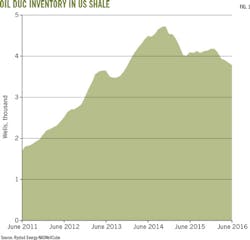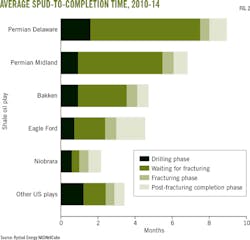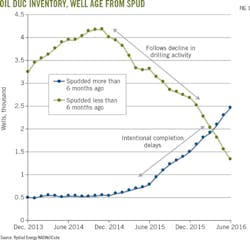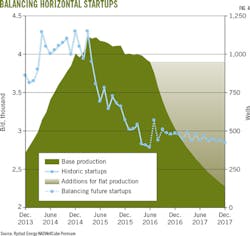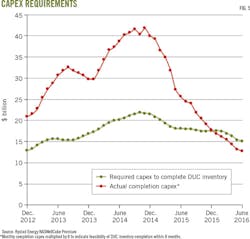US DUC inventory likely to shrink over next 8-12 months
Artem Abramov
Rystad Energy
Olso,Norway
Many drilled but uncompleted (DUC) oil horizontal wells across US shale plays will become commercial if light, sweet crude oil prices remain at $40-50/bbl on the New York Mercantile Exchange.
Companies would have to spend an estimated $15 billion to complete an existing DUC inventory of about 3,700. Actual near-term spending is expected to be less. Operators are on track to spend $12.7 billion in the next 8 months on DUCs if spending stays at the June level.
Producers likely will boost completion spending when they become confident of a sustained oil price recovery. A total first-year production potential of 1.15 million b/d exists in DUC wells.
About 90% is commercial at $50/bbl, 80% at $40/bbl, and 55%, or 650,000 b/d, at $30/bbl. The Permian basin offers the largest cumulative DUC production potential of the US shale plays at 340,000 b/d.
Economics vary considerably across a given play. The Permian basin contains both very high-quality acreage and areas far from commerciality. Within the Permian, operators have focused attention on both the Delaware basin and the Midland basin.
The Delaware basin on average exhibits slightly better well-economics than the Midland basin.
The Bakken formation has 290,000 b/d of cumulative potential. It offers the most attractive DUC economics with an average breakeven price of $28/bbl. Only 10% of potential Bakken DUC production requires breakeven prices higher than $38/bbl.
DUC inventory outside the three largest liquid plays can add an estimated 200,000 b/d of first-year production at an average breakeven price of $61/bbl.
The Denver-Julesburg basin offers DUC production potential of 100,000 b/d. An average DUC well in Weld County, Colo., exhibits a breakeven price just below $30/bbl. Total Colorado oil output will expand by 55,000 b/d in the first year if all these wells are completed simultaneously. A more realistic gradual ramp-up in activity will likely generate 5,000-10,000 b/d in monthly additions over 10-12 months.
Light, sweet oil prices in early June reached about $51/bbl, triggering significant completion of DUC wells across shale plays. That completion activity will result in additional oil production for several months.
If prices recover further, the pressure-pumping market might face a spike in demand for hydraulic fracturing, which could prompt higher service contracts.
Anadarko Petroleum Corp. decided in early 2016 to complete DUCs rather than focus on new drilling, saying a significant part of its new drilling had turned uncommercial. Anadarko completed 46 DUCs during the first quarter while drilling only 26 new wells.
Whiting Petroleum Corp. resumed completion operations in the Williston basin in late June as part of a 44-well participation agreement with an unidentified partner. On July 28, Whiting also announced a separate 30-well participation agreement in its Pronghorn area of the Williston basin.
Whiting plans to add a Pronghorn-area rig in October, saying it would increase activity in the second half and complete 16 gross (12.5 net) DUC wells in the Williston basin.
DUCs climbed
US completion expenditures grew before 2015. At the end of 2014, operators were spending more than $5 billion/month on horizontal oil well completions.
The DUC inventory reached an estimated required capex of $22 billion as of Dec. 31, 2014, but producers started trimming completion budgets in 2015, decreasing completions every month before stabilizing spending in June-August.
The anticipated drop in the DUC inventory will show up as a sudden production gain.
Gains in an individual producer's shale production tend to happen abruptly. Many mid-size shale operators lack continuous completion-services agreements so well stimulation happens in intervals.
A fracturing crew works wells on several adjacent pads simultaneously, resulting in numerous wells coming onstream at about the same time and yielding a significant production increase.
An operator might wait several weeks or months before deciding to complete more wells. Meanwhile, drilling activities continue and DUC inventory builds.
Fig. 1 shows the almost monthly growth in the DUC inventory for US uncoventional oil plays from June 2010 through November 2014, reaching 4,700 wells by late 2014.
A 4-month DUC backlog developed 2010-14 because of a mismatch between drilling and completion schedules. Operators need time for field testing to develop the most efficient completion design for individual wells within plays and subplays, accounting for delays between spud and completion. Infrastructure issues also contributed to delays.
More wells were completed than spudded in early 2015. The DUC inventory stabilized at 4,000-4,200 wells in the second half of 2015. Operators in shale plays intentionally delayed completions because of low oil prices.
This article uses spud dates rather than total depth or rig release dates in its DUC calculations. State regulators typically require reporting of spud and completion dates.
DUC phases outlined
Fig. 2 shows a typical spud-to-completion timeframe in several phases for horizontal oil wells completed 2010-14 across major US shale plays.
Average drilling time ranged from 2 to 6 weeks. The subsequent wait-for-frac phase was the largest source of completion delay in most plays, reflecting producers' intentional slowdown.
The exception was the Niobrara, where most activity came from a handful of DJ basin operators with developed infrastructure. The DJ basin average time from rig release to the beginning of well stimulation was less than 2 weeks.
In the mature Bakken and Eagle Ford plays, the time averaged 2.6 and 1.7 months, respectively. Some emerging shale formations within the Permian basin took 4.6-6 months because of the time required for field testing.
A completion crew takes an average of 1-2 months to ready a well for production. Delays become unlikely once producers commit to completion spending. But production decline resulting from completion delays is not straightforward. The DUC inventory can be split into two groups: wells spudded more than 6 months ago and wells spudded less than 6 months ago.
Fig. 3 shows how these two parts of the DUC inventory evolved December 2013-June 2016.
The new part of the DUC inventory grew during 2014. A peak of 4,200 wells occurred in the fourth-quarter 2014.
As drilling activity collapsed, the number of DUC wells spudded less than 6 months ago also fell. DUCs decreased by almost 70% from the fourth-quarter 2014 to June 2016.
The number of old DUC wells held stable in 2014-early 2015, fluctuating around 500 wells. As intentional completion delays mounted, however, the number of old DUCs started growing rapidly, increasing 400% by June 2016. More than 2,400 wells were spudded longer than 6 months ago, almost 65% of the entire DUC inventory. In fourth-quarter 2014, old wells accounted for 10% of the DUC inventory.
The DUC inventory is huge relative to drilling and completion activity. Fig. 4 shows historical oil production from horizontal wells across US shale liquids plays. It also shows the number of monthly well startups. If no new wells are added, production will decline from 3.89 million b/d to 2.25 million b/d, or 42%, by December 2017.
About 400 oil horizontal well startups/month occurred in the second-quarter 2016, down more than 60% from fourth-quarter 2014.
Third-quarter 2016 startups would have to increase to an average of 500/month to maintain production at 3.89 million b/d. As base production matures, the balancing number of startups will decrease to 430 wells/month by fourth-quarter 2017.
Flat production through Dec. 31, 2017, would require 8,200 new horizontal oil wells, more than twice the current DUC inventory.
Production additions from the DUC inventory alone could maintain US shale oil output at current levels only for 7-8 months. Significant drilling activity would be required to offset production declines after that.
Fig. 5 shows the total completion capex that would have been required to bring the entire horizontal oil DUC inventory onstream from December 2012 through June 2016.
The actual US shale oil monthly completion capex was multiplied by 8 to indicate feasibility of DUC inventory completion within 8 months if spending stays constant with June levels.
The author
Artem Abramov ([email protected]) is a Rystad Energy senior analyst focused on upstream exploration and production data from governmental sources along with empirical research of well-production profiles. Abramov is product manager for the NASWellCube, Rystad Energy's shale well database. He holds an MS in financial economics (2013) from BI Norwegian Business School, Oslo, and a BS in applied mathematics (2011) specializing in statistics from Novosibirsk State University, Russia.
